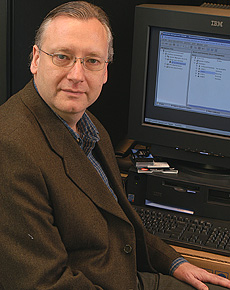
News Release
|
Office of News and Information Johns Hopkins University 3003 N. Charles Street, Suite 100 Baltimore, Maryland 21218-3843 Phone: (410) 516-7160 | Fax (410) 516-5251 |
February 13, 2003 FOR IMMEDIATE RELEASE CONTACT: Phil Sneiderman (410) 516-7907 prs@jhu.edu |
In Heart Disease Research
Hardware, Software Expedite Study of the Role of Genes and Proteins
Johns Hopkins University researchers are using IBM technology to discover how genes and proteins can influence heart disease. By understanding the origins of heart disease at the molecular level, the researchers hope to gain insights that could lead to new, more effective drugs for treating heart-related illnesses.
Through a Shared University Research (SUR) award from IBM, Johns Hopkins has received IBM hardware and software technology for the university's new Center for Cardiovascular Bioinformatics and Modeling. Researchers at the center will use the technology to simulate complex and highly detailed models of heart cells, tissues and organs and look for variations in gene expression during disease states. This knowledge could result in new drug targets and better predictions about the effects of drug candidates on animals and humans. In their efforts to find out what triggers heart disease, Raimond Winslow, director of the Center for Cardiovascular Bioinformatics and Modeling, and his colleagues are measuring and recording the behavior of thousands of genes at one time. "In many diseases, there are significant changes in gene expression," Winslow said. "That's what we need to characterize: which genes are switched on or off and which sequences have important health consequences. Our job is to identify disease mechanics at the gene and protein levels, then identify a drug target that might be useful in treating the disease."
 |
|
Raimond Winslow Photo by Will Kirk |
The SUR award also will help accelerate the development of global-scale file management software that can give geographically dispersed organizations, including researchers affiliated with the center, direct access to information stored at many sites, using high-speed, high-bandwidth networks.
"Large-scale file systems are exciting in that they support collaborations like the Center for Cardiovascular Bioinformatics and Modeling by allowing researchers to share information among campuses across the globe," said Randal Burns, assistant professor in the Department of Computer Science and director of the Hopkins Storage Systems Lab. Burns received a portion of the SUR award to support his research.
 |
|
Randal Burns Photo by Will Kirk |
The technology backbone for these Johns Hopkins' research projects is the IBM Life Sciences Framework, an open, scalable architecture developed to make disparate data and applications interoperable. The architecture includes an IBM eServer p690 computer equipped with 16 microprocessors and 64 gigabytes of memory; a 7-node IBM eServer xSeries Linux cluster; a fibre-channel storage area network powered by IBM's FAStT Storage Server to house data in a central site that can be accessed by many computers; and a robotic Vitual Tape Server subsystem that can store 28 terabytes of data. Middleware will include IBM's DB2 Universal Database, which will be used to manage the massive amounts of data resulting from Johns Hopkins' research, and IBM DiscoveryLink data integration technology, which will enable the integration of disparate biomedical data sources. IBM WebSphere Internet infrastructure software will facilitate efficient data and application sharing among researchers working in separate locations.
"Johns Hopkins University is clearly a leader in biomedical research," said Beth Smith, director, IBM Life Sciences Solutions Development. "The creation of the new Center for Cardiovascular Bioinformatics and Modeling will be a strong catalyst for cross-disciplinary collaboration and will advance the use of information technology in discovery research. IBM is delighted to be Johns Hopkins' technology partner."
A key goal of the new Center for Cardiovascular Bioinformatics and Modeling is to facilitate knowledge sharing and collaboration among research organizations, including scientists at the university's Whiting School of Engineering, where extensive research is underway on the heart and brain using image analyses; the Johns Hopkins School of Medicine; Queens University in Ontario; and the University of California, San Diego.
IBM's Shared University Research program awards computing equipment (servers, storage systems, personal computing products, etc.) to colleges, universities and institutions of higher education around the world to facilitate research projects in areas of mutual interest, including life sciences, grid computing, autonomic computing and deep computing. These SUR awards also support the advancement of university projects by connecting top researchers in academia with IBM Research personnel, along with representatives from product development and solution provider communities. IBM supports approximately 50 SUR awards per year worldwide. Color images of Raimond Winslow and Randal Burns available; contact Phil Sneiderman
Related Links:
Raimond Winslow's Web Page:
http://www.cmbl.jhu.edu
Johns Hopkins Biomedical Engineering Department:
http://www.bme.jhu.edu
Randal Burns' Web Page:
http://hssl.cs.jhu.edu/~randal
Johns Hopkins Computer Science Department: http://www.cs.jhu.edu
|
Johns Hopkins University news releases can be found on the
World Wide Web at
http://www.jhu.edu/news_info/news/ Information on automatic e-mail delivery of science and medical news releases is available at the same address.
|
 Go to
Headlines@HopkinsHome Page
Go to
Headlines@HopkinsHome Page